Explores how Xu Bing and other contemporary Chinese artists use Western ideas within a Chinese cultural discourse.
How Chinese is contemporary Chinese art? Treasured by collectors, critics, and art world cognoscenti, this art developed within an avant-garde that looked West to find a language to strike out against government control. Traditionally, Chinese artistic expression has been related to the structure and function of the Chinese language and the assumptions of Chinese natural cosmology. Is contemporary Chinese art rooted in these traditions or is it an example of cultural self-colonization? Contributors to this volume address this question, going beyond the more obvious political and social commentaries on contemporary Chinese art to find resonances between contemporary artistic ideas and the indigenous sources of Chinese cultural self-understanding.
Focusing in particular on the acclaimed artist Xu Bing, this book looks at how he and his peers have navigated between two different cultural sites to establish a third place, a place from which to appropriate Western ideas and use them to address centuries-old Chinese cultural issues within a Chinese cultural discourse.
表中的内容
Acknowledgments
List of Illustrations
A Dilemma in Contemporary Chinese Art: An Introduction
Hsingyuan Tsao & Roger T. Ames
1. Reading and Misreading: Double Entendre in Locally Oriented Logos
Hsingyuan Tsao
2. Reading Xu Bing’s A Book from the Sky: A Case Study in the Making of Meaning
Roger T. Ames
3. Seriousness, Playfulness, and a Religious Reading of Tianshu
Kuan-Hung Chen
4. Making Natural Languages in Contemporary Chinese Art
Richard Vinograd
5. The Living Word: Xu Bing and the Art of Chan Wordplay
April Liu
6. Transmission of Meanings: A Study of Shen Wai Shen (Body Outside Body) by Xu Bing
Kazuko Kameda-Madar
7. The Space Between: Cross-Cultural Encounters in Contemporary Chinese Art
Jerome Silbergeld
Appendix 1. Bibliography on Xu Bing and Related Issues in Contemporary Chinese Art
Zoe Li
Appendix 2. List of Important Events between 1979 and 2005
Susan Chang
List of Contributors
Index
关于作者
Roger T. Ames is Humanities Chair Professor in the Department of Philosophy at Peking University. His published works include translations of the Chinese philosophical canons and several interpretive studies.












